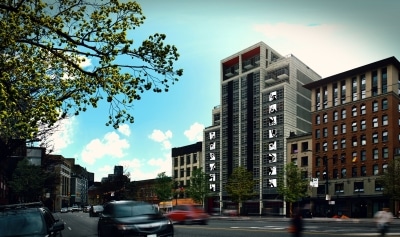41 East Hastings Project

What is the 41 East Hastings Street Project?
The 41 East Hastings Street project will provide 52 units of housing rented at current maximum shelter allowances to women and women-headed couples who have experienced chronic homelessness. Referrals will come from women-only housing where women are thinking of leaving or have given notice in order to live with male partners.
What is the 41 East Hastings Street Project?
The 41 East Hastings Street project will provide 52 units of housing rented at current maximum shelter allowances to women and women-headed couples who have experienced chronic homelessness. Referrals will come from women-only housing where women are thinking of leaving or have given notice in order to live with male partners.
Why the need for these units?
In Atira’s experience, a failed relationship is one significant factor leading to women’s experience of chronic homelessness and repeat use of shelters. In almost all cases it is the woman who ends up homeless when a relationship fails. Atira estimates that at any given time, eight of 10 women in its short-term shelters are repeat users.
By housing women-headed couples, this project has the potential not only to prevent women’s repeat homelessness, but also to create double the vacancies (104) elsewhere in the system, freeing up those rooms for others who are homeless.
Program Mission
The program will be based on the following principles:
Women Centered: The 41 East Hastings program will recognize the gender differences in experiences of homelessness, violence, substance use, and mental health issues.
Trauma Informed: The 41 East Hastings program will understand that women are at far greater risk of violence/abuse from those close to them (Covington, 2008).
Harm Reduction: The program will work to reduce risks related to substance use, while not requiring abstinence.
Low Barrier: Housing and services at 41 will be targeted at women who face multiple barriers in accessing housing, so will strive to have as few barriers as possible preventing women from accessing services, or requiring them to leave. Outreach workers and counselors will come into the housing to provide services to women.
Anti-Oppression: Services will be based on an understanding that Aboriginal women, women of colour, lesbian, bisexual, queer or transgendered women, women with a disability and women who use substances may experience discrimination in our society and face multiple barriers to accessing services that intersect in various ways with the oppression they face as women.
Relationship Building: A focus on establishing ongoing supportive relationships of trust with women by those providing services at 41 East Hastings. Such relationships have been found to be key for women in exiting unhealthy, violent or exploitative relationships (Clark, Ladha & Henderson, in progress; Hartling, 2003).
Safety First: Establishing services that are safe and do not re-traumatize women is crucial for women who have experienced violence (Cory & Dechief, 2007). Establishing safety (emotional and physical) will be a first priority when women first come to the building/program, and maintaining the ongoing safety of all the women residing there will take precedence.
Service Model: A “menu of possibilities” will be offered to the women living at 41 East Hastings. With the exception of the live-in residential care worker these are not new services, but existing supports already provided by partner organizations to women in the Downtown Eastside.

Community Partners and Funders
We have employed a number of inventive financing tools to bring this project to completion including partnering with the private sector (Cressey) which will build the project, donating back the construction management fees, which amounts to an almost $1 million contribution; a portion of the project’s architectural services are also being donated.
We will air parcel and sell the 67 market units to a group of investors, using the profits to subsidize the cost of the non-market units and significantly reduce our debt. We will launch a traditional fundraising campaign, chaired by the previous land-owners, with a goal to eliminate all debt on the project.
Project development funding has been provided by CMHC and Vancity Credit Union. We also anticipate securing construction financing through B.C. Housing, which further reduces capital costs. It is the combination of all of these financing tools and resources that will make this project successful.
